Ten Years on from Fukushima (6/6): Conclusions
The disastrous accident in Fukushima Daiichi occurred exactly ten years ago, on 11 March 2011. In the last few weeks, our article serie has highlighted the causes, the sequence and the effects, as well as describing the conclusions that we have been able to draw from the accident.
The events in Japan are a reminder that we must never let down our guard. It is essential to ensure the safety of Swiss nuclear power plants right up until their final days of operation. Fukushima has shown only too painfully that one of the keys to maintaining safety is continuous and consistent backfitting based on the latest state of science and technology.

One positive outcome of the fateful accident in Fukushima is the valuable findings it delivered. International comparisons and reviews of both engineering and regulation demonstrated that Switzerland had done its homework: not only do the nuclear power plants fulfil all the recommendations proposed by international committees, they also rank very highly in international comparisons on safety. Swiss regulations and standards in respect of nuclear safety are exemplary and the Swiss regulatory function is fully independent.
Even if we in Switzerland already meet high safety standards, Fukushima Daiichi provided us with plenty of valuable information on how the safety of Swiss nuclear installations can be improved. We have set out this information in the Fukushima Action Plan. Based on this, we were able to mandate further backfittings. Moreover, we published our analysis of the accident in six Fukushima reports. In two of these reports we analysed the human and organisational factors behind the accident; a third report will likely be published today to mark the tenth anniversary of the accident. In addition, numerous findings have been incorporated as safety requirements in legislation and in ENSI’s regulatory framework and will continue to be incorporated in the future. Furthermore, we sanction the regular review of our regulatory activities by international specialists. In this context, an IAEA IRRS Mission will take place in Switzerland this October. International experts will review our regulatory activities and the Swiss system in relation to nuclear power plant safety. Also, we are committed to meeting high safety standards and harmonising regulatory practice both at home and internationally.
Moreover, the accident in Japan shone a light on another important aspect: emergency preparedness. Here too, Fukushima is a useful reminder not to lull ourselves into a false sense of security. Despite taking every precaution, there will always be a residual risk. Therefore, it is our duty to ensure, both in Switzerland and abroad, that the consequences of any accident are mitigated as far as possible. In this sense, Fukushima meant that the international radiation protection and emergency preparedness community and all countries operating nuclear power plants have been confronted with the question of whether their protection measures are really appropriate. Of particular interest here is the precautionary evacuation of the population, which in Switzerland is also envisaged as an important strategy in protecting against any possible radiation exposure following an accident in a nuclear power plant. Fukushima demonstrated that, contrary to popular opinion, radiation exposure as a whole was relatively moderate. There were no fatalities due to radiation and a medium and long-term increase in cancer cases is, according to several international studies (e.g. UNSCEAR, WHO, IAEA), not to be expected. Nevertheless, to some extent the large-scale evacuations had severe effects on the affected population. There were numerous deaths. The causes were varied and range, for example, from temporary interruptions to medical care because of the evacuation of hospitals, senior residences and care homes, through to psychiatric illnesses and their after-effects.
Once again, this finding places the focus of considerations on the sheltering strategy: evacuations are not the only conceivable measure that could be taken to protect the population in the event of a nuclear accident. Were a radiation exposure event to occur, the outstanding basic fabric of Swiss residential buildings would already make an important contribution to protection against ionising radiation. Not only that, the Covid-19 situation has shown that sheltering, i.e. staying at home with reduced time outside, can be highly effective for limited periods. ENSI is therefore attempting, by means of both national and international discussions with its emergency preparedness partners, to weigh up and consider the advantages and disadvantages of various protection measures, and when and how these measures can be combined.
Here, a central point is and remains how to deal with the deep-routed uncertainty and anxiety of many people in the face of radioactive radiation. These often-amorphous fears must be taken seriously. In future, ENSI will not only have to inform people in responsible positions and the emergency services about radiation and the resulting effects in association with nuclear power plant accidents, but also the general republic. However, this does not mean that we are playing down the disaster in Fukushima and the ionising radiation resulting from it. Rather, it is a question of keeping the risks resulting from radiation in proportion.
To summarise, where Switzerland is concerned we must not rest on our laurels, but should remain constantly alert and critical, regularly reviewing the available technology and regulatory tasks, and ensuring that nuclear installations are upgraded based on the latest state of the art of science and technology up until their decommissioning. The German politician Philip Rosenthal once said “Whoever stops trying to improve, has stopped being good”. Exactly the same applies both to the licensees of nuclear installations and to ENSI! The focus here, both now and in the future, is that ENSI will continue to make its decisions free from political and economic pressures and that it will continue to be able to secure and retain the necessary skilled personnel to do so.
Marc Kenzelmann, Director ENSI

